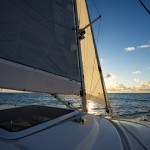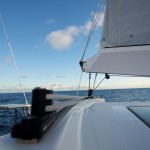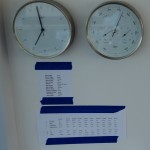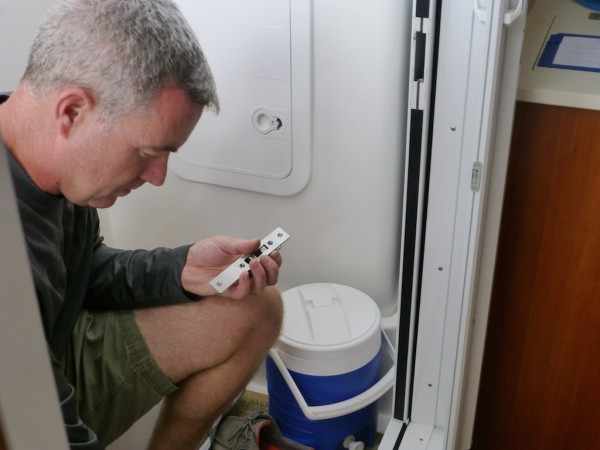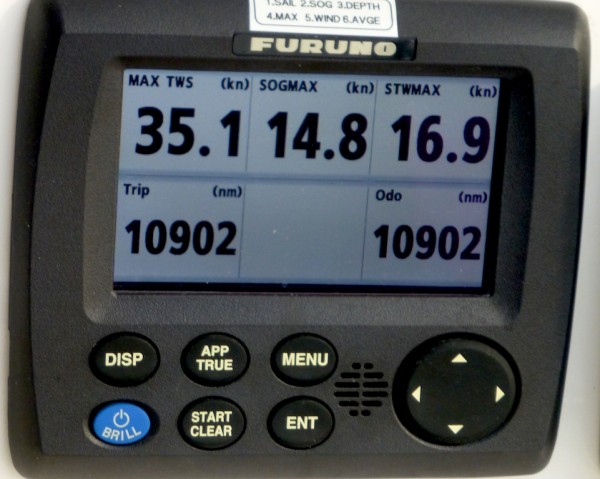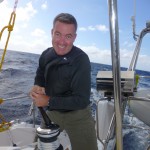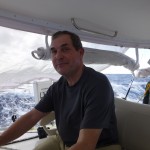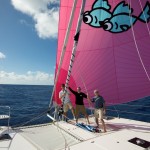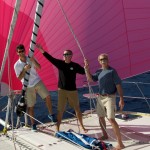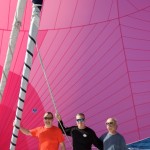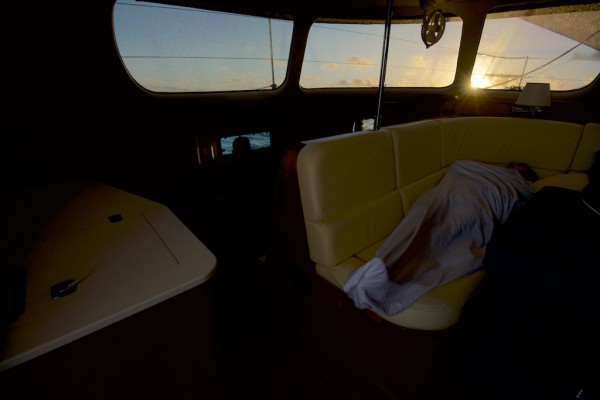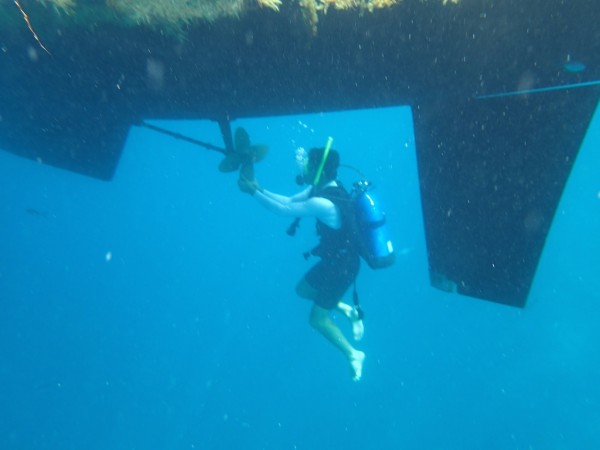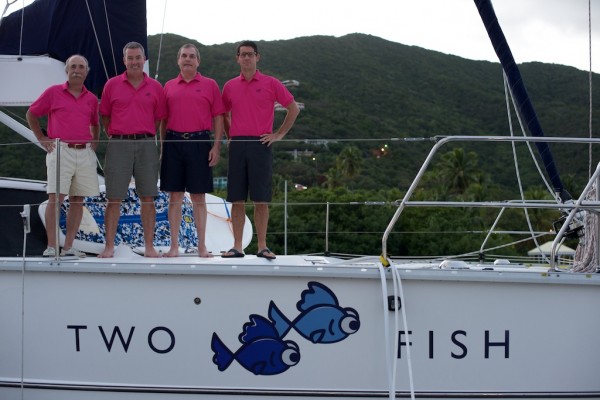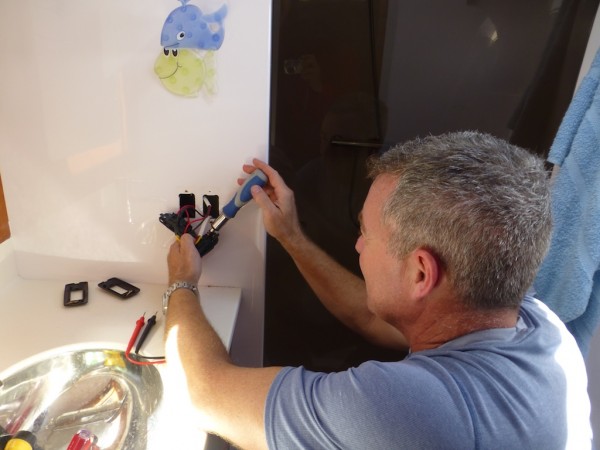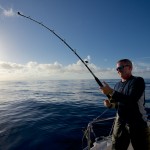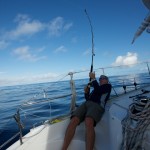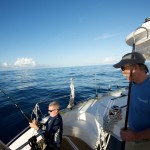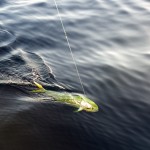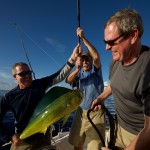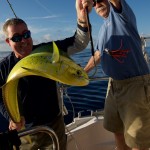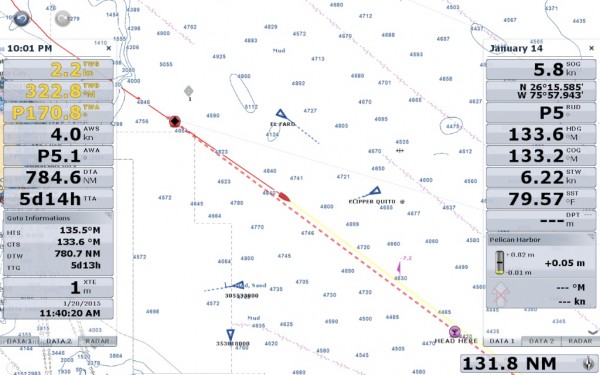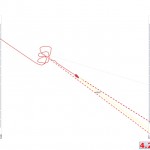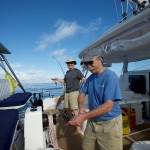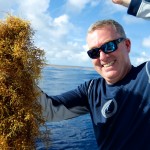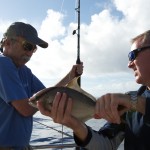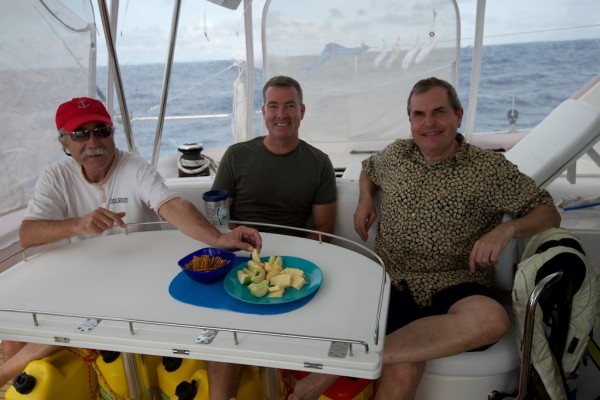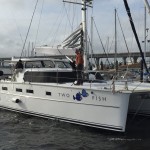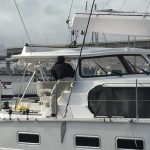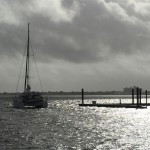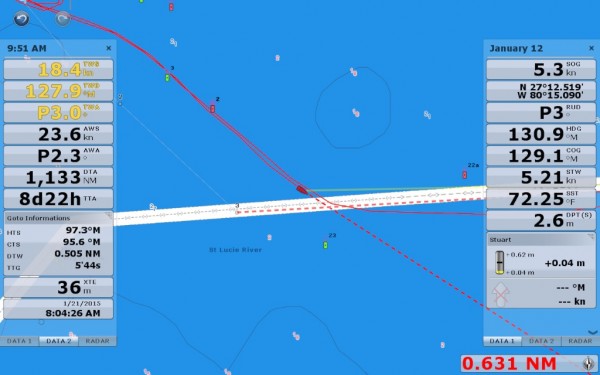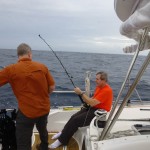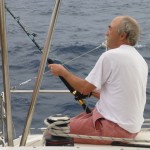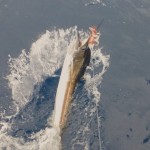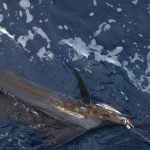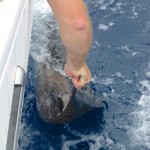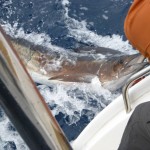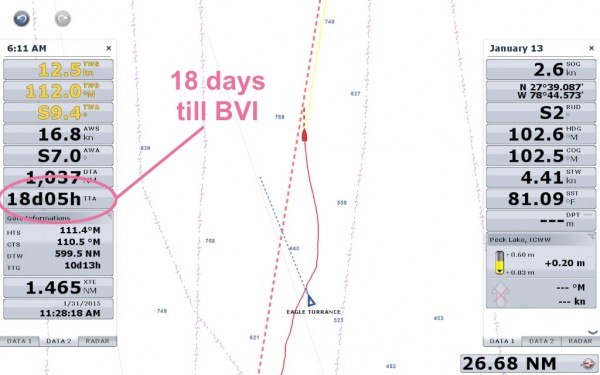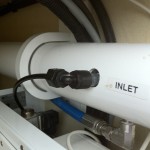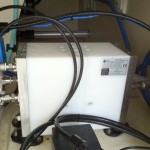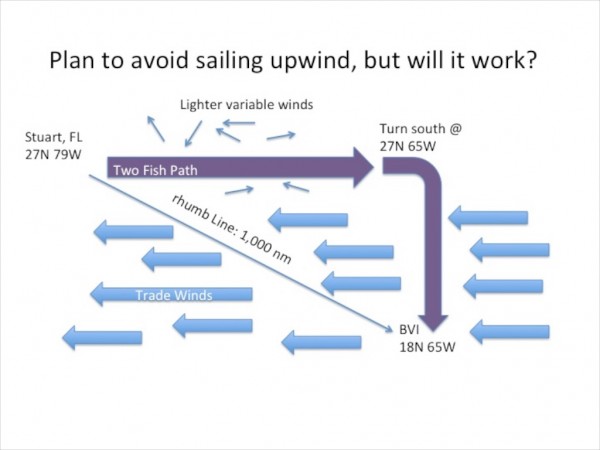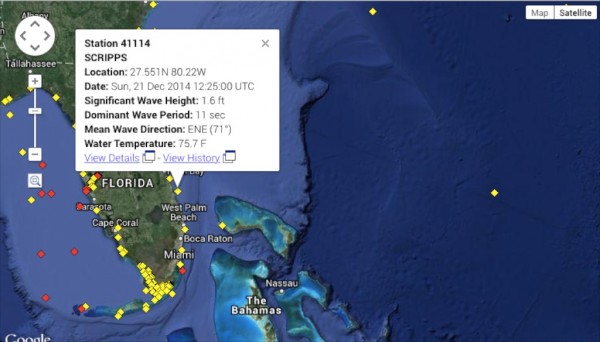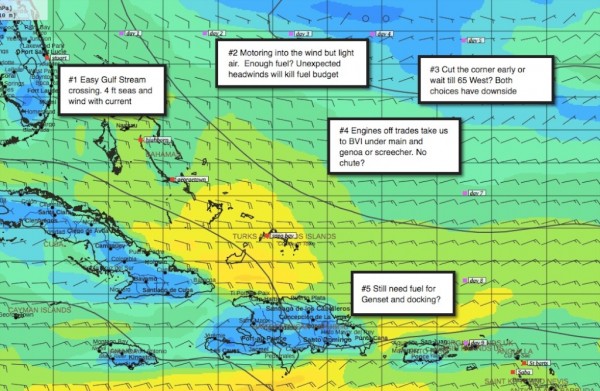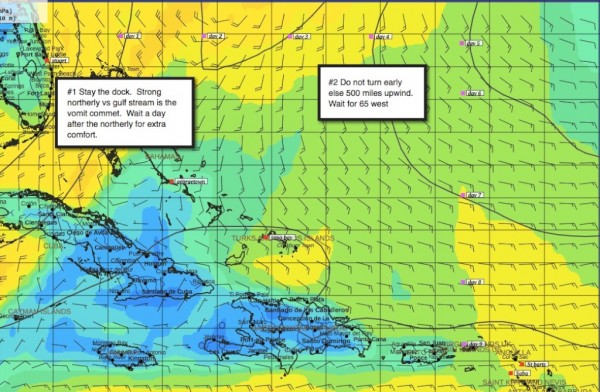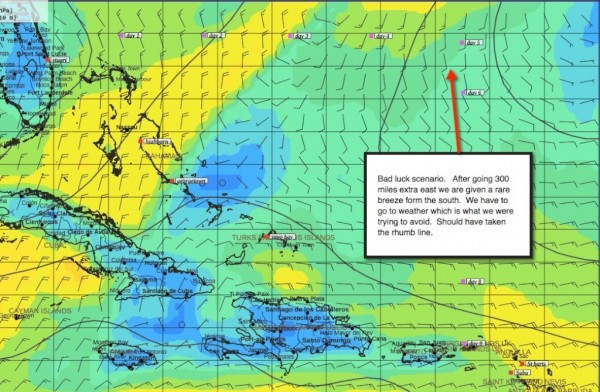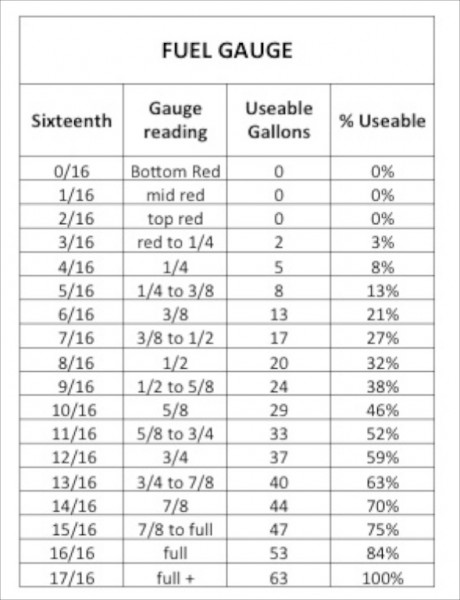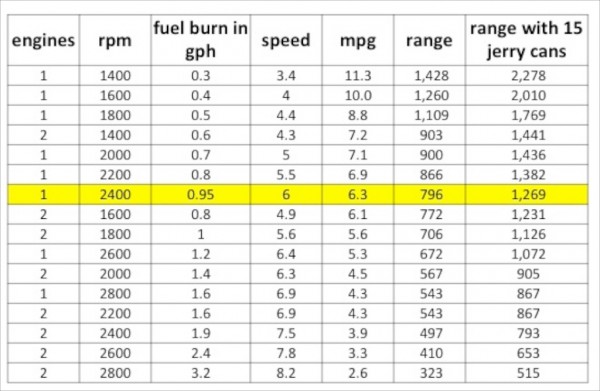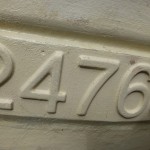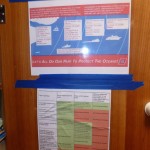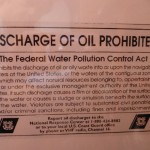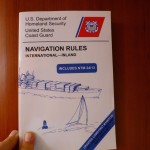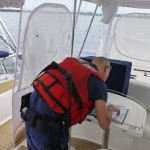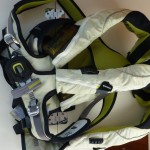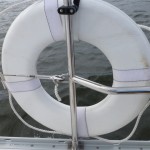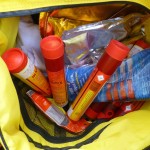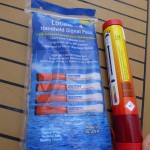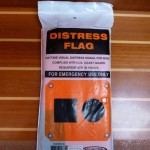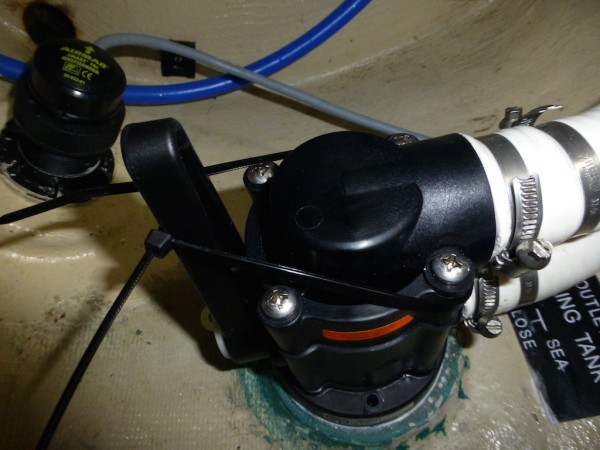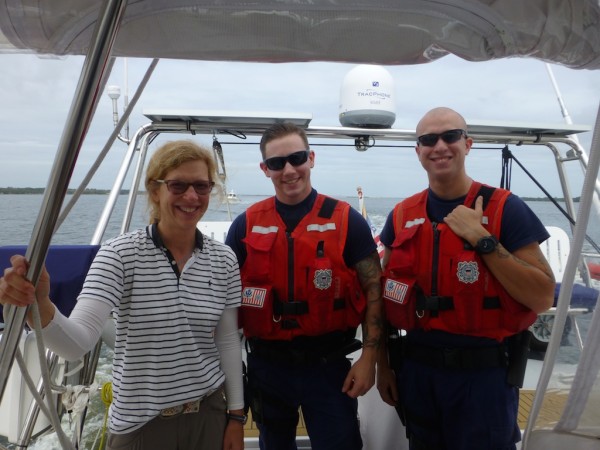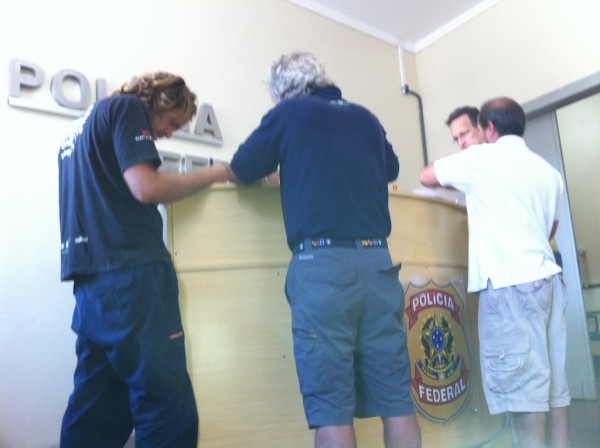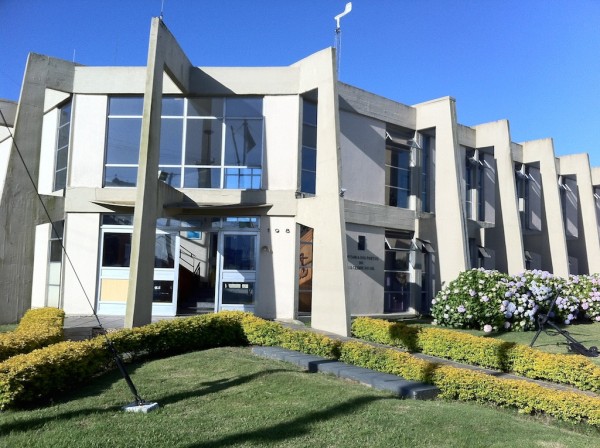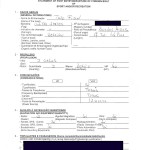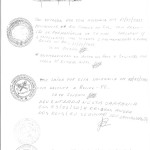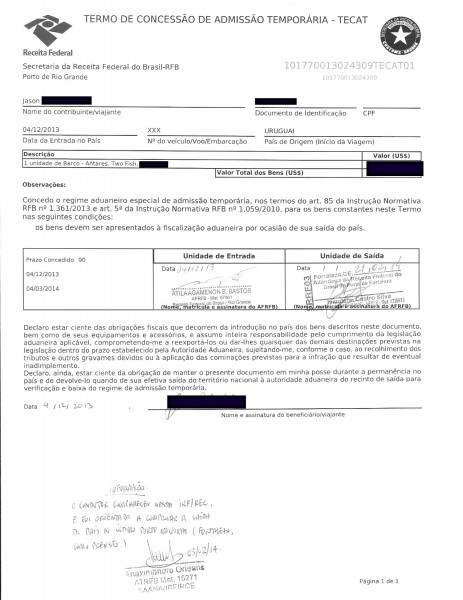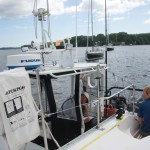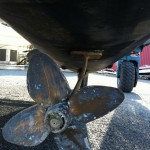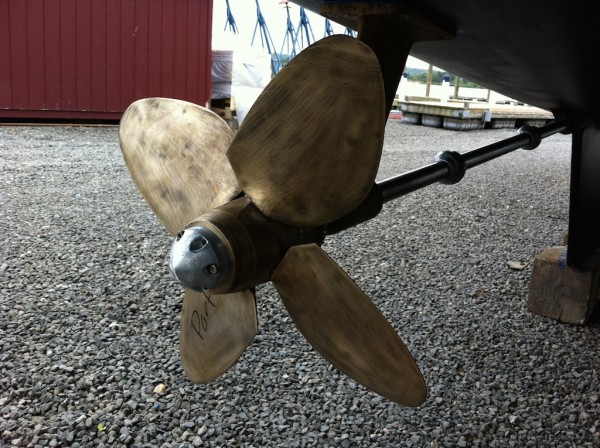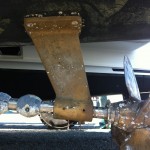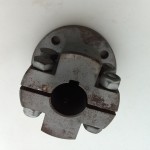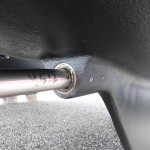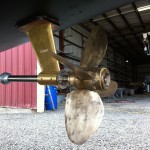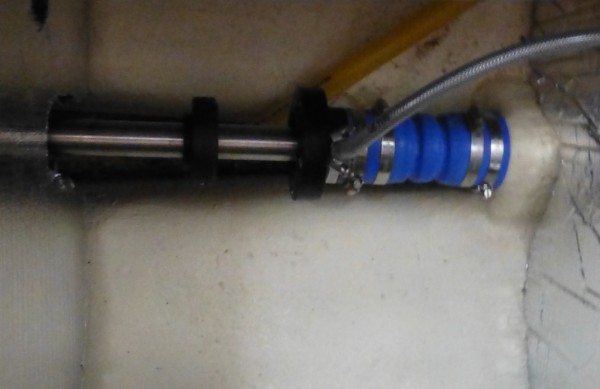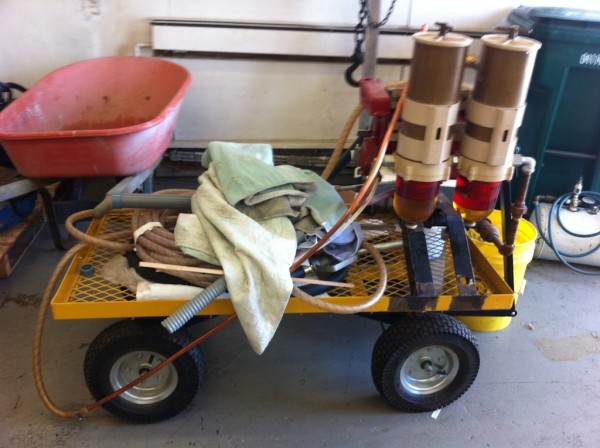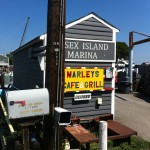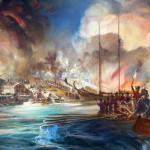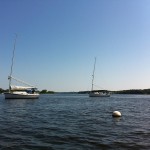Waiting for a semi-custom boat to be built offers plenty of time to consider what features to choose. The Antares comes with just about everything so it is difficult, BUT not impossible to create add-ons. However, the additions you decide on during the build can only be based on inputs from previous owners and brief trips aboard, rather than your own lifestyle. After a year aboard, we have firmer views on what we want from the boat. WARNING. Before you ask Antares to add features to your new boat please follow two rules: 1) Do not tell them it was my idea, and, 2) This boat has a long wait-list so the factory is focused on keeping up with their production and you may have to customize it after splashing. Waiting will help you figure out your own preferences.
I like an organized boat. So some of our upgrades have been about making things more organized for a cleaner look aboard and in the lockers. I think the bilges should be as clean as the cabin.
Permanent Storage boxes in the Genset locker and the Watermaker Locker
-
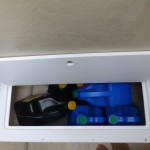
-
Watermaker locker box
-

-
Aft Locker box closed
-
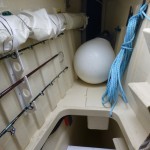
-
Genset Locker
-
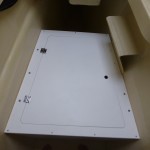
-
Box Closed
-
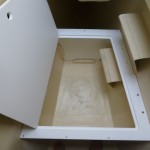
-
New box open
It is early days with this new creation but I love it. Now engine oil, coolant, and other fluids have a home aboard Two Fish. The Genset locker box is so huge it can hold a large tub. We store our baja filter, fuel siphon and other oily bits in this space. The box also creates a space in front of the box for holding our oil extractor. No, we are not starting a small fracking operation, this tool is for oil changes. No longer do I have to tie down the oil cans. Also entering and exiting the lockers is much easier now as the boxes make a great place to put your feet. Finally, the boxes can be removed if necessary for some unusual service. Maybe Antares will make them standard in a future boat? Remember rule #1, do not mention my name if you ask for it.
Fridge and Freezer Fans
-

-
Freezer fan
-
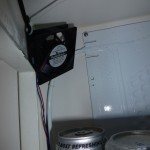
-
Fridge fan
-
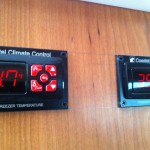
-
Fridge+Freezer Thermostat
Marine fridges and freezers are not as powerful as our 110 Volt models onshore. The symptoms that we have seen are excessive condensation, frost and troubles achieving and maintaining a very low temperature. We have improved the fridge seals, ensured the proper compressor coolant pressure and have now added fans. We hope to have the best in marine refrigeration. The fans should address the issue of uneven temperatures. Initial testing is good but serious testing will start when we arrive in warmer weather. In Charleston, we could have kept our stores cold by leaving the door open. We also upgraded the thermostats to a digital model.
Bilges
-
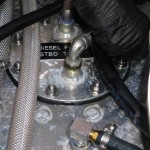
-
Fuel tank inspection port
-

-
Sealing fuel tanks
-
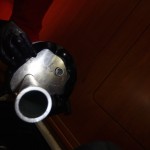
-
Low quality gasket
We had some initial problems with fuel not staying in the fuel tank. There is nothing worse than the smell of diesel, but we eventually sorted out the problem. First, we replaced the gasket in our fuel tank inspection port. The previous material was failing under the assault of diesel with additives. The new material is pricey, but Viton seems to keep the diesel in place and does not degrade. Second, we tested the tank for micro leaks when filling the tank to full. A few bolts were leaking so we re-seated them with a sealant known for is diesel resistant power. We now have a tanks that keep the diesel trapped.

Bullet proof gear shifter
Our next bilge upgrade was preventive. Antares Guru, James, told us about power catamarans that had the shifter connection come off. Murphy’s Law requires this failure to occur next to the fuel dock. Imagine that you are locked in gear headed at pricey boat. For the cost of a few nuts, this seemed to be a worthwhile upgrade. James installed longer bolts, extra nylock nuts and some Loctite to defer a visit from Murphy.
-
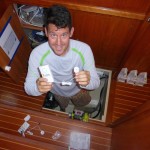
-
Installing flood alarms
-
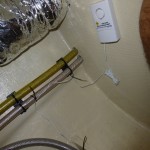
-
Water alarm
-
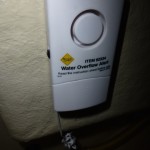
-
Flood alarm
-
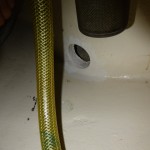
-
Limber hole
When we first got the boat, the watermaker had a fatal flaw and created a small pool of water in the bilge. This led to fears about the boat flooding in strange compartments without my knowing. We bought a bunch of inexpensive water alarms that run on 12 volt batteries and placed them near possible flood spots. We also added limber holes under the master and guest bed so those areas could empty into the main bilges.
-
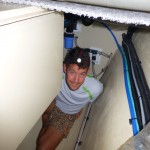
-
Installing gear hammock
-
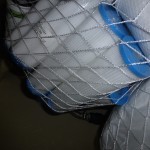
-
Gear hammock with filters
-
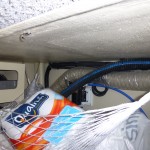
-
Under master bed
I have avoided storing anything under the master bed because the area contains the lift pump for the watermaker. A year has passed since our initial issues, so I decided to store some rarely used items there. Accessing this area is almost as easy as swimming to shore mid-passage. Our huge collection of watermaker filters was a perfect candidate for remote under bed stowage. I installed 3 gear hammocks that keep the filters, oil blankets and paper towels out of the bilge.
Clock and Barometer
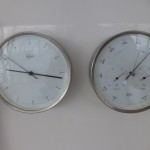
Barigo Clock and Weather
These units were chosen for their looks and not their accuracy as marine instruments. They need to be polished to avoid rusting. The weather device has humidity, temperature and the all-important barometer. We keep track of GRIB files with a high regularity and the barometer is not currently a huge focus.
website for the clock maker
USB for 12 volt
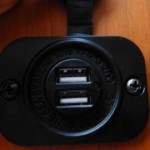
BlueSea USB
With our iPhone anchor alarms, iPad podcasts and other amp-consuming applications, we have a constant need for charging our Cupertino friends. We had plenty of cigarette lighter style outlets, but the adapters always got warm; this deeply concerned me and curtailed their use. Now we have replaced these fire hazards with a USB outlet from BlueSea. They work great and should be standard on all boats. Check out this post on the charging or take my word for it.
Canvas Customization
-
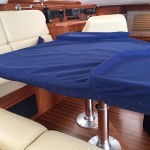
-
Wrinkles are hard to avoid
-
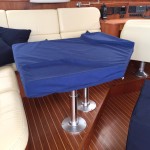
-
Interior table cloth
-
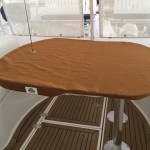
-
Table cloth for outdoor dining
-
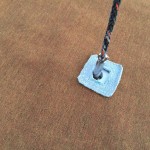
-
Hole for table support
-
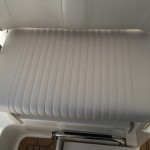
-
New base for helm seat
“Hello sir. I would like to buy two table cloths. The first is for a table that is sort of oval with a line holding it up at one end. The other one is more complex, has wings and is a pentagon.” said Gail.
“Please leave the store” said the store employee.
That is what would happen at a department store if you asked for the two tablecloths we had custom-built in Charleston. The canvas shop was efficient and made a quality product. It is a joy to have a proper table cloth for outdoor dining and the indoor cloth protects the table during passages.
We never loved the quasibucket style design of our helm seat. It had padding that pitches you forward at an odd angle and a ridge in the middle. Also, a key seam failed on Two Fish and some early boats. I think the seats are now made with a better material so the failure is less likely. The manufacturer sent us a replacement seat but we chose to construct a new design. This design is flat and matches the pattern of the cockpit cushions. So far it has been very good for both of us, especially as we like to sit in the lotus position while on watch.
Preventer system
-
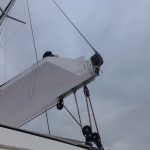
-
Loop at boom
-
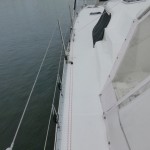
-
Overview
-
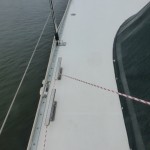
-
Preventer turns on cleat
-
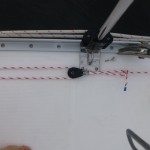
-
purchase
-
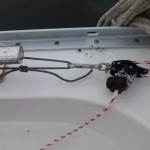
-
control
This creation is over-engineered. Or may be over Jason-ed as the engineering might not pass muster at an MIT inspection. The system has the goal of being an easy to operate preventer. (For non-sailors, it is preventing the boom from violently swinging over to the other side if the wind shifts.)
1) When not in use, only a loop remains attached to the end of the boom. This makes for a cleaner cockpit.
2) When it comes time to use the preventer, it is easy to attach. A simple clip system from the preventer attaches to the end of boom loop.
3) The preventer line uses the mid-ship cleat to turn the line aft.
4) Finally, the system has purchase and is controlled with a repurposed dinghy mainsheet block.
The traveler on the Antares is basically a preventer since the mainsheet is kept short. Remember to cleat BOTH sides of the traveler at all times. The preventer is another layer of protection from accidental jibes and also can be used to shape the main sail. A less obvious usage is to reduce mainsheet slap. The Antares mainsheet passes under the salon and in lumpy seas and light air the mainsheet will slap the bottom of the salon. Nothings gets me on deck faster than hearing the sheet slapping the underside of the salon. My best technique to eliminate this noise is to ease the vang and tighten the preventer. The new system is easier to tension than the old one (a simple line to the cleat).
Other Rigging changes
-

-
Battcars
-
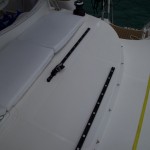
-
Twin Genoa Tracks
We disagreed with the design of the mainsail cars on the Antares. Before you take my word as gospel, there are many boats that have sailed 10,000 miles without incident with the factory set-up. The factory set-up uses small harken cars so that when the sail is dropped the head is not too far off the deck. This is a laudable feature but does not give the most robust Harken solution. We installed batten cars at every batten and reef cars at every reef point. The intermediate cars standard on the boat are friction sliders and they were replaced with ball bearing cars. This may be overkill, but it allows for smoother drops and a more robust attachment of the main to the track. We re-cut our sail cover and added a few mast steps to adjust for the higher mainsail stack. Gail can still put on and remove the sail cover. She can also frap the main halyard with a little help from the boat hook.
Organizing the Genset locker
-
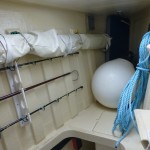
-
Home for polls and sunshade
-
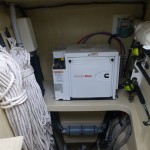
-
Looking aft
-

-
Everything has its place
-
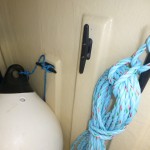
-
Note reinforcement strips
-
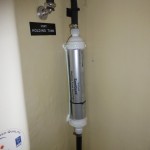
-
Holding tank filter
The Genset locker holds long lines which are useful in narrow rivers and tight anchorages. They are also useful when warping or leaving a Med moor. One line is 300 feet, the other 150 feet and the final is 70 feet of propellor avoiding polypropylene used for grabbing mooring balls from the stern steps. The fishing polls are out of the way and there is a custom place for the aft sunshade. Most owners store their sunshade on the dinghy arch. The genset locker is so organized and clean, I am thinking of inviting guests over for drinks in the locker.
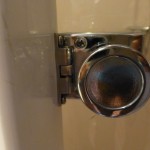
Slam Latch left of knob
Shower door lock
In big seas, the master shower door can fly open. Many owners sail blue water with an extra line tied from the door handle to the sink. Effective, but hobo style. Two Fish added a slam latch to the existing latch. The latch can be adjusted via a screw to create the correct pressure to keep the door closed in a big sea. Better yet when the factory makes a new door they need to hang it such that the mechanism goes deeper into the catch.
VHF position
-

-
Stowed – old position
-
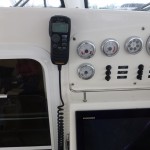
-
Underway position
Many boats install their VHF above the bilge pumps. One person can then be at the helm, and the other can operate the VHF. However, the flaw with this installation is that the VHF speaker is facing to port and is hard to hear while helming. The solution is to add another dock for the VHF higher up so it can be heard by all and reached by all. When the trip is over the VHF returns to its old dock where the canvas cover protects it from exposure. Small change but big benefit when transiting the ICW where there are frequent communications.
Entertainment cabinet
-
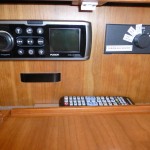
-
Fusion with aux-in switcher
-
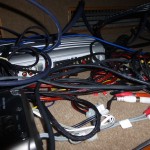
-
Space-wasting mess
-
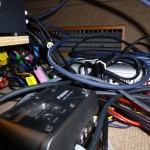
-
Before: space was useless
-
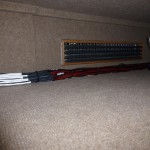
-
Cleaned up wires
-
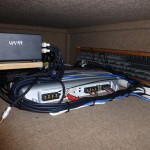
-
Cleaned up amp
-
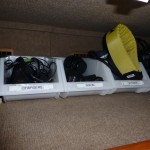
-
Everything has a place
-
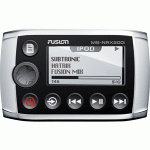
-
Wired remote at helm
-

-
iPhone remote
Under the salon TV, there is a huge space but the boat builders used this area to run wires. For a year, this has driven me nuts. That created the energy needed to change the set-up. We cleaned up all the wires and moved hardware behind the Fusion stereo. With a large space ready for organization and a quick trip to The Container Store, vital stuff now has a safe place. Binoculars with compass, stabilization binoculars, air horn, rangefinder, camera, VHF chargers and more, all have homes. This change is a huge lifestyle improvement.
Since day one, the Fusion stereo has had a wired remote at the helm. I find it nice to be able to quickly stop the music to hear the VHF or law enforcement. Recently, we connected the Fusion to our 12 volt router and “bingo”, now iStuff can control the stereo with album art. Not necessary but very nice.
Screecher
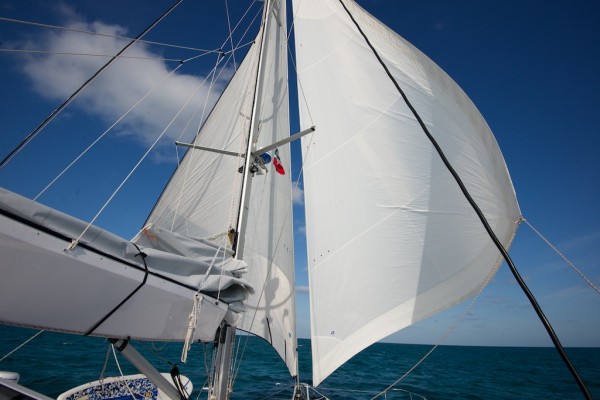
Screecher
This is a must. Traveling dead down wind with Genoa and Screecher is a joy. Power reaching with Main and Screecher is fast and fun. 100% happy I got this sail and the bowsprit installed. At some point I will change the reefing line to a continuous line and snatch block for winch reefing like sister ship Calypso has already done. However, I have hand-furled the sail in over 20 knots with no issues.
Self tacking Jib
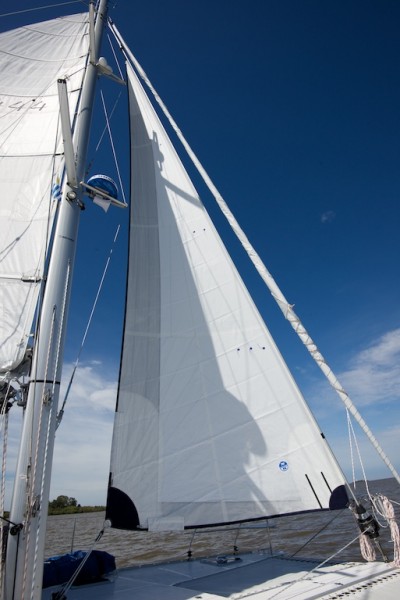
Self-tacking Jib
We have not used this, except for testing. If we sailed a lot in cold weather, or, short handed, the sail might get more use. The furled Genoa works ok in very strong breezes (40knot) when off the wind and does not require the crew to go forward to drop and bend on a new sail. However, having the Jib offers back up if a head sail winch were damaged. I would consider skipping this option and having a cleaner foredeck, one fewer line in the chaseway, and a few more bucks in the wallet.
Underwater Lights
Before I get new owners too excited about adding features to their boats, I would warn that a simple boat is easier to learn and may have fewer initial problems. You can add many systems later as you learn your preferences.
-

-
Underwater Light controller
-
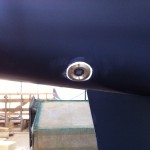
-
Underwater Light
-
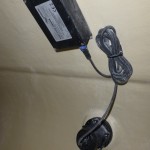
-
Light controller inside hull
We bought these lights under the advice of Live Wide. The factory did a great job installing the units. Lumishore lights are bright and make any color under the rainbow. We turn them on when we are expecting guests. We do not mimic sport fishers and leave them on during the evening when in the Marina. We do enjoy their ability to attract fish at night, but would rather sharks stayed away.
Glendinning power cord reels
-
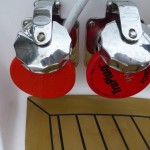
-
Cord exit on aft stairs
-
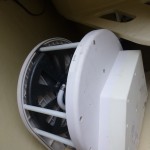
-
Empty spool in aft locker
I do not think this option is offered anymore, and I think we are the only boat with this feature. It has worked flawlessy. The job of stowing cords is made shorter as the electric reels spin the cords away. But the biggest benefit is the reels are in a place where you would never store something. This frees up space in the valuable cockpit locker where traditional cord owners store their power cords. Also having the power at the stern rather than mid ships often leads to a cleaner hook-up to the power post. As you can see in the photo we put plugs into the cord exits when in use. If there is large chop, water will not enter the boat (very very rare).

Cords stowed
Single Side Band Radio (SSB)
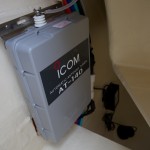
SSB
We do not use it much. A little over a year since moving aboard, is sometimes too early to know your eventual go to items. For example, we did not use our heat for 9 months, but we would have frozen to death, or at least never gotten up in the morning, on the ICW as an early winter caught the southbound sailors. Likewise, the SSB might come in handy in other parts of the world. Part of our low usage is because we have not mastered using it as a modem. We hope to make some friends in the BVI that will give us tips on controlling it with the MacAir. We know it works well since we have used the radio for long distance communication.
Roller main versus slab reef main
-
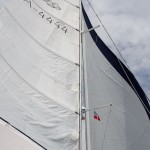
-
Powerful slab reef main
-
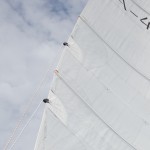
-
Reef blocks on main
This topic could consume a blog post. One of the joys of cruising for me is working the sail plan. Putting a reef in the Main at night when the breeze is climbing is a skill. Not a tricky skill, but one learned with practice. If you find no sense of accomplishment in that process, then install the Roller Main. The Roller could allow for a more balanced helm in a big blow as you can hoist a tiny Main and tiny head sail. The slab reef can not get smaller than 2 reefs and so one must go Jib alone. In theory, this will create a less balanced helm. However, in strong winds we have not found the helm poorly balanced with our slab reef Main. I know one owner who installed a third reef on his Main. Interesting, but I did not follow his lead because it would force me to leave the cockpit and it would create too many control lines. Having blocks installed on the leech of the main is a must for easy reefing. The Slab Reef Main has a huge amount of extra sail area in the roach. After one reef is installed in the Slab Reef Main, it is the same size as the full Roller Main. This extra sail area can be nice on a light air day or going upwind. It is also very difficult to tension the leech on the Roller Main which limits performance in certain conditions.
I support the purchase of the Slab Reef Main 100%, while Gail partially supports the Roller. She is concerned about the Roller not working one day but is jealous about the Roller Main being push button in and out.
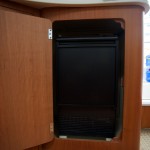
Ice maker
Ice maker
We do not use our air conditioning often, but really enjoy an ice-cold drink. We have hung the ice maker power supply off the inverter so solar power can make ice. Our bit to stop global warming. The factory-installed model works very well but others prefer their plug-in models from Amazon. The plug-in is easy to replace but is slower and requires water to be added by hand. Oh, the rough life of a cruiser. Gentlemen do not cruise without an ice maker?
Printer Shelf
-

-
Printer drawer
-

-
Printer revealed
Two Fish is not just a sailboat but also our home. No home office can survive without a printer/scanner to fill out entry forms, file taxes and other pedestrian paper work. Many cruisers place the 110 volt printer in a locker. Gail was not excited about diving into a locker every time she needed to print. Instead, Two Fish has a printer located behind a custom wood door in the settee. The carefully sized printer slides out effortlessly, making that quick print job painless and curse-free unless Jason left the printer without paper. We have straps to keep the printer in place during passages, but this may be excess.
Woodwork
-
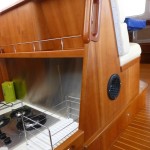
-
Big sea handles
-

-
Desk grommet for cables
The factory is great on woodwork details. We added shelves to the bottom of our closets. We also added a grommet in the Nav Station so that power cords pass nicely to the laptop. We copied Live Wide and added a handle for safe passage from the galley to the salon. I will add more shelves in the master hull cabinets, but they will not be as beautiful as the Argentine cherry.
Chain counter
-
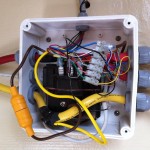
-
Initial wiring
-

-
Cleaned up wiring
-

We were the first boat to ask for a chain counter and a remote at the helm. This was new technology for Antares and we had some initial glitches. But after we cleaned up the wiring, in the junction box the gremlins fled and it has been a joy. Most folks have a coloring scheme on their anchor chain to tell how much chain has been released. I found this system difficult because the zip ties fell off and I could never remember our color code system. With this system, both anchor person and helmperson can see how much chain is down. Often the diligent person weighing anchor (Gail) is working terribly hard on cleaning the anchor as it is being raised and may on occasion forget to tell the helmsman (Jason) that the boat is adrift. With the remote located at the helm, this problem goes away. In rare occasions this remote is useful for Med-Mooring or single handed anchoring.
Solar power
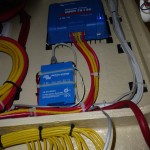
New solar controller
Nothing beats solar power on a boat. Silent and great at top-up charges. Our boat was ordered with the two extra large panels on the dinghy arch. I may add more some day as solar requires no effort. We recently replaced our defective solar controller. The symptom was the need to be rebooted by removing the fuse with some regularity. Victron sent a new unit ASAP so it might be a known glitch. The new unit is a small upgrade to our unit (more amps and includes their new communication protocol). So far I am just happy not to be yanking the fuse all the time.
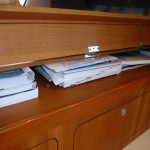
Chart storage
Chart storage
We always have paper charts on board (Gail rule) so this is a must to keep the cabin organized. I will skip the debate about their need in the modern world. Gail likes them, so they are aboard. We also tend to buy every cruising guide we can find. Bluewater Books is a great store for buying guides. However, sometimes I avoid reading the guides so I can be surprised by what is onshore. I do always read their navigational tips so as not to be surprised by a rock. Remember the old sailing adage, surprised by a beach bar is a good thing – surprised by a rock is a bad thing. Told you sailing is not a complex activity.
Nav station input strip
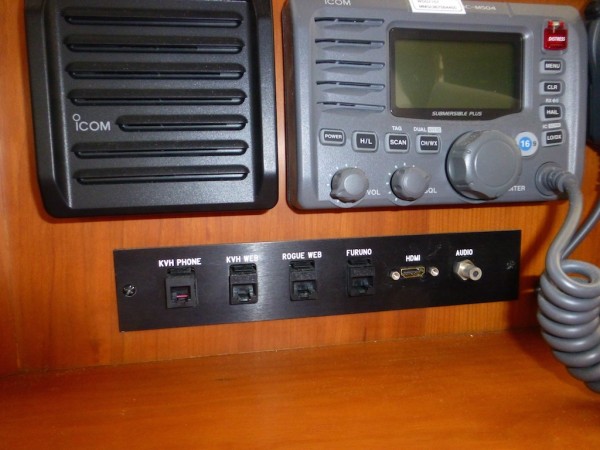
Plug central
This was Gail’s discovery and has worked well. Older boats just had wires coming out of the hutch. Ugly and leads to broken wires. This strip cleans up the mess. Which inputs do we use? KVH web frequently in passage for our internet. In order to not use data by accident we do not serve up the expensive satellite internet wirelessly. HDMI is used when we watches movies from the laptop on the big TV. KVH phone is only a back-up since the Iridium is a quicker phone solution. Rogue Web is only used if there are debugging issues with our wifi extender. Furuno allows MaxSea navigational software to get the data from the network. I keep forgetting what settings are required to make this work and Gail has to keep fixing it for me. Audio allows any audio source to go into the Fusion stereo.
Fish Finder
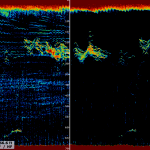
Fish Finder display
This one missed the mark. A simple depth sounder is enough. Our fish finder consumes power and only offers a graph of what you have passed over. The fish finder helps in understanding the contour of the bottom when anchoring. I turn it on when anchoring, gunk-holing or passing through a tight passage. I am too hopeless a fisherman to use it to increase our catch. One advantage of the fish finder is that it is a back up for the depth sounder and my starboard hull is wired for a transducer upgrade in the future if my mood changes.
Port forward cabin selection
We have the storage option instead of a small pipe berth or an office. An office seems excessive since when we need to work we use the nav station or the salon table. Computer work inside a hull could be stifling. The pipe berth has merits but we prefer convenient access to our tools on nice shelves. Boat work is never a picnic so you do not want to be lifting cushions every time you need a different tool. The second shower option was not available when they built our boat. I can see the advantage but guests typically shower outdoors when the weather is warm enough. The sail locker has been convenient for storing the chute, canvas covers, and extra cleaning supplies.
Factory sold Canvas covers
The helm cover is a must. Protects the expensive navigational equipment in no time. The dinghy cover has limited usage since we are full time live-aboards. If we left the boat for an extended period of time, this would be used. Winch covers were a bit too small and need to be replaced. Helm seat cover is not used as the enclosure is often up, thereby protecting the helm. We enjoy the convenience and protection of the canvas rear winch cover.
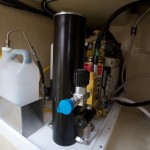
Dive compressor
Dive compressor
So far it has been underused, but we expect that to change as the next 6 months as we will be in perfect waters for diving. I will report more on this feature later. It was installed in a very clever location so you end up losing almost no space. However, there are dive shops that can fill your tanks. 2 x 62 liter tanks fit nicely in our stern line lockers and a rack in the locker can hold 2 x 80 liter tanks. The compressor takes less than 30 mins per tank and can fill up to 4 tanks at a time. We have a 110 volt fan to keep the compressor cool during fills and a nice cover to protect the compressor from accidental splashes.
KVH V3
This is an expensive option at start up but costs only $50 a month to keep running. In the right parts of the world, it is fast and is a very convenient way to access the internet for weather, email or web surfing. The KVH has come through for us in dealing with mundane finances and last year’s retirement.
Nav Station Set-up

Iridium Extreme phone
The Iridium’s primary purpose is to go into our ditch bag in case of emergency. It works just like a cell phone so any crew member can operate the phone in case of emergency. For our upcoming trip I have the 6 different Coast Guard numbers pre-programmed. I wonder if I should also include Domino’s pizza? Do they deliver mid-ocean? The Iridium can also download data but we use it for GRIBs and text emails only, as the speed is only 4kbs. Your home network work is probably 40,000 kbs. We have an antenna for the Iridium on the dinghy arch.
Vesper Vision AIS
The Vesper has been a great AIS. It seamlessly sends the AIS data to our Furuno system. The feature we were happily surprised by was the ability of the unit to broadcast data from the NMEA network. If that mumbo jumbo makes no sense to you, what it is saying is that wind speed, depth and other data are sent out wirelessly anytime the unit is turned on. A few bucks at the app store and you can buy slick applications that will show this data. Now in the middle of the night if you want to know the wind speed you can check it with out getting out of bed. My current project is to get iRegatta to calculate VMC. (That is another post!)
Furuno RD33 data display
This data repeater is a workhorse for Two Fish. Location makes log book updates easy. Also, while at anchor the windspeed alarm is a nice safety feature. The compass is a convenient way to detect wind shifts.
Flexiteek

Flexiteek
I would get the fake teak again. It hides dirt, reduces glare from the deck, and adds charm to the boat (subjective). The short coming is that it can get very hot, so we wear flip flops. Footwear is never a bad thing for a boat. Your feet thank you by the end of the day. Stains can be sanded out and as it ages it looks more real. The black caulking lines need some maintenance over time.
Bigger Water Maker
I have passed through the valley of broken watermakers and emerged a stronger man. Let me tell you the long story. I am assuming that since you made it this far into the post, you must be a glutton for punishment. We foolishly left the factory with an untested watermaker. When we turned it on the hoses blew off. For those not into watermakers, this is not a good sign. We had three issues.
1) Our watermaker has a lift pump and an energy recovery unit. The latter takes place of the high pressure pump. It is called an ETD. The ETD, now a swear word on Two Fish, was milled incorrectly. The two pistons inside the ETD would get stuck and become a blockade for the incoming water. As the pressure built, the weakest link would fail and a hose would go flying. We did develop the ability to remove the ETD and unlock the pistons. This would take about 6 hours and only give you one usage of the device. After a comedy of errors, we finally connected with a new ETD sent by the factory and replaced the unit in Trinidad. It turns out the watermaker manufacturer had done a recall on this part but never got around to telling Two Fish or the factory. Since replacement, the unit has been flawless.
2) Our water maker has a electronic valve that opens after the 1 minute priming period has passed. Our first 2 Danfoss valves were duds. We have had perfect performance from our third valve but we also carry a spare. I bet the early valves may have been damaged by the misbehaving ETD.
3) Original installation had a few poor hose connections. Pikin was a hero in Brazil; after four attempts, he found a guy who could crimp a high pressure hose that was forgotten in the install process.
After all my complaining what do I think of the watermaker. It is now set and forget. It makes water just fine and the speed is appreciated. During passages I will run the Genset for 2 hours to charge the batteries and can make 50 gallon of water at the same time. I apologize to the crew who were aboard during the drought. They were such great sports.
Chaise lounge / Dual Genoa tracks
-
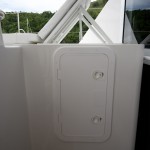
-
Extra storage
-
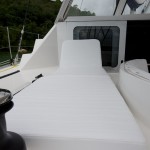
-
Chez Lounge
I thought I would be on the chaise all day long and I am surprised I use it less that expected. Every time I use it for a reading perch I appreciate how cool a spot Antares has created. The cost for this is not having the extra helm seat, which I find a bit out of place anyway. So it is a double winner. Gail created her own co-pilot seat by buying a huge matching Sunbrella cube which we use both outdoors and indoors for extra seating. Another double winner for the price of one. By having the chaise we also got a very nice storage box on deck.
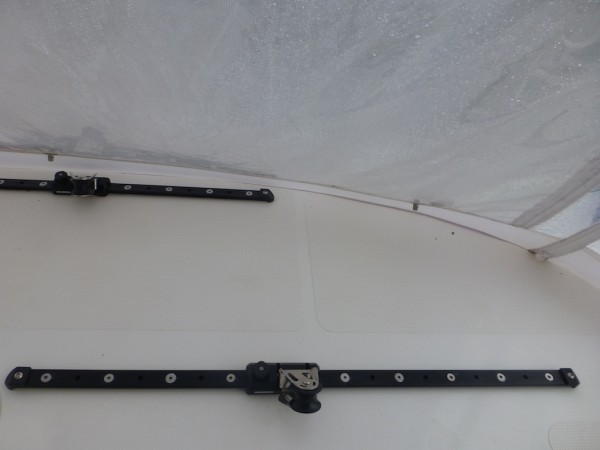
Dual genoa track
We had two genoa tracks installed on Two Fish to get better sail trim and accommodate more of the enclosure. I would not consider this a must have item. It is a nice to have for back up and fun for sail trim but not a must. We are cruising after all!
Final small stuff
I can not believe you have made it this far into the post. Congrats on the epic job of reading through mud. Our final customization has been adding hooks to the master head. You can not have enough when you go swimming 3 times a day. We also added an anti-siphon loop to the genset bilge pump. This may be a small risk but a reverse siphon could occur on the bilge output for the genset as it is close to the water line. We added a vented loop to stay extra safe. In the South Atlantic we did notice water was entering via the bilge pump system. We followed Golden Glow’s lead and installed new cool toilet seats. They should be standard. Easy to clean and no slamming. We also added fiddles above the microwave and above the cooktop.
Future projects
Most important project is not to do any projects for a while and enjoy swimming, diving and exploring ashore. But I have some thoughts:
1) Copy Field Trip and hang the watermaker power off the inverter.
2) Copy Live Wide and add an AC vent to cool dive compressor
3) Add shelves to cabinets
4) Add adjustable genoa cars. Add bow block to fly chute from windward bow.
Remember do not ask Anatares for all these features or no one else will get a boat before 2030. Enjoy your boat, your favorite upgrades will most likely be different than mine.
